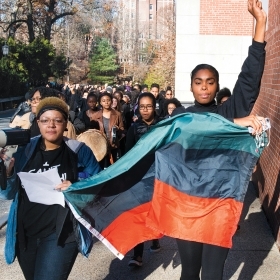Within minutes of the campus email announcement, social media was buzzing.
“New multicultural space!”
“We did it y’all. Look at kbot’s email!”
“@Wellesley announces plan to enhance multicultural spaces on campus. Important step in the right direction.”
The announcement prompting the online flurry came in early December from Wellesley’s president, provost, and interim dean of students: that the College would be converting Acorns, the former residence of the dean of students, into multicultural space, and would enhance Harambee House—all with the intent of creating a network of such spaces in the Tupelo Lane area of campus.
Acorns, a midcentury modern building located on the lake next to Harambee House, will provide meeting and event space for student gatherings; offices for advisors to students of Asian descent, Latina students, and LGBTQ students; a kitchen; and a limited amount of storage space. Harambee House, which will remain focused on students of African descent, will receive repairs and upgrades to its lower level. Work was slated to begin early in second semester, with renovations completed no later than the opening of the 2016–17 academic year.
Students have long sought such a step. “It has been a continuous effort since the 1970s to secure a multicultural space, and it is important to remember that [this] is a direct result of student activism and labor on this campus,” says Multicultural Affairs Coordinator Ananya Ghemawat ’17. “Countless individuals … have protested, demonstrated, and fought for this.” The President’s Commission on Ethnicity, Race, and Equity, constituted by President H. Kim Bottomly in January 2015, also added its voice to the chorus calling for multicultural space.
“People from disenfranchised groups often get messages—you can call them microagressions—about whether or not they belong or whether or not they’re accepted,” says Robin Cook-Nobles, dean of the Office of Intercultural Education and director of the College’s counseling services. “So let’s say you’re a member of a disenfranchised group and you’re out in the world and someone asks you a question and you feel different by that question being answered. It takes some psychological energy.”
Though every person is different and has different needs, Cook-Nobles adds, the ability to be in a space with individuals who share common experiences and identities is “like going home. You can just relax and be yourself … and not feel like you’ve got to answer … or defend or educate. People can get renewed to do what they need to do.”
Programming for the space and how it will be used will be developed by students and their advisors, says Interim Dean of Students Adele Wolfson. Many different student organizations will be using the space, necessitating concurrent events and meetings. Storage is also limited. Wolfson acknowledges the need for additional multicultural space in the future. After gauging how Acorns functions, “we’ll work out what other kinds of spaces are needed,” she says.
“We know it’s not perfect,” Cook-Nobles agrees. “The other areas that need to be addressed—we need to give it more thought. But we don’t want to lose the progress or the momentum. … We should celebrate this.”






We ask that those who engage in Wellesley magazine's online community act with honesty, integrity, and respect. (Remember the honor code, alums?) We reserve the right to remove comments by impersonators or comments that are not civil and relevant to the subject at hand. By posting here, you are permitting Wellesley magazine to edit and republish your comment in all media. Please remember that all posts are public.